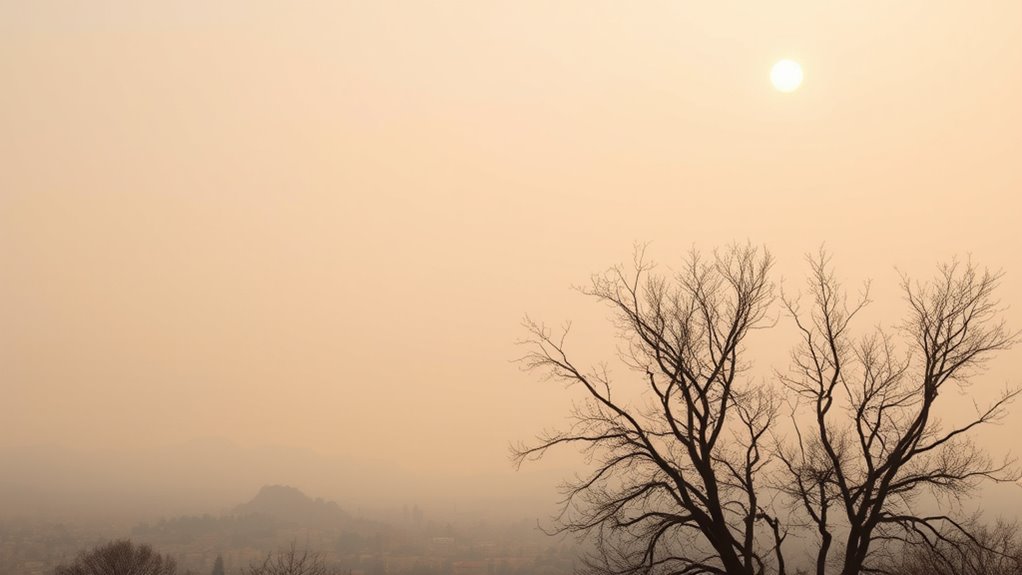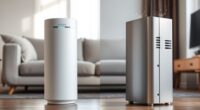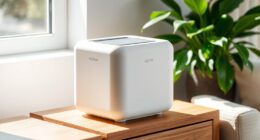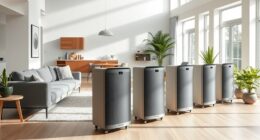To prepare for seasonal air quality changes, stay aware of pollen counts in spring and summer, and keep indoor allergens under control year-round. During wildfire season, use HEPA filters, seal gaps, and stay informed about air quality alerts to limit smoke exposure. In winter, boost indoor humidity and stay hydrated to combat dry air. You’re about to discover simple strategies to protect your breathing all year round.
Key Takeaways
- Monitor local air quality reports regularly to anticipate high pollution, pollen, wildfire smoke, or dry conditions.
- Use air purifiers with HEPA filters and keep windows sealed during wildfire smoke or high pollen days.
- Maintain indoor humidity levels with humidifiers to prevent respiratory dryness in winter.
- Limit outdoor activities during peak pollen, wildfire smoke, or cold, dry weather to reduce exposure.
- Stay prepared with masks, extra filters, and emergency plans for wildfire smoke and seasonal pollution spikes.
Understanding How Seasons Impact Air Pollution Levels

Seasons considerably influence air pollution levels, shaping the quality of the air you breathe throughout the year. During colder months, urban pollution tends to increase because of factors like heating and stagnant air, leading to higher concentrations of pollutants. In contrast, warmer seasons often see a decrease in some pollutants, but summer can also bring spikes due to increased vehicle emissions and outdoor activities. Seasonal variations affect how pollutants disperse and concentrate, impacting overall air quality. You might notice worse air during winter, with smog and particulate matter lingering in the air longer, or cleaner air in milder weather. Recognizing these patterns helps you prepare for periods of poorer air quality and take steps to protect your health during high pollution seasons. Incorporating natural elements into your environment can also help mitigate some effects of seasonal pollution and promote a healthier indoor atmosphere.
Recognizing Common Allergy Triggers During Different Seasons

As air quality fluctuates throughout the year, so do the common triggers that can set off allergy symptoms. During pollen peaks in spring and summer, outdoor allergens like tree, grass, and weed pollen become major culprits. You might notice increased sneezing, itchy eyes, or congestion when pollen counts are high. Indoors, allergens such as dust mites, pet dander, and mold thrive year-round, especially in humid or poorly ventilated spaces. Recognizing these triggers helps you manage your allergy symptoms better. For example, staying indoors during peak pollen times or using air purifiers can reduce exposure. Being aware of seasonal changes and indoor allergens allows you to take proactive steps to minimize allergy flare-ups and breathe easier throughout the year. Additionally, understanding air filtration technology can help in selecting effective air purifiers to improve indoor air quality.
Preparing Your Home and Environment for Wildfire Smoke
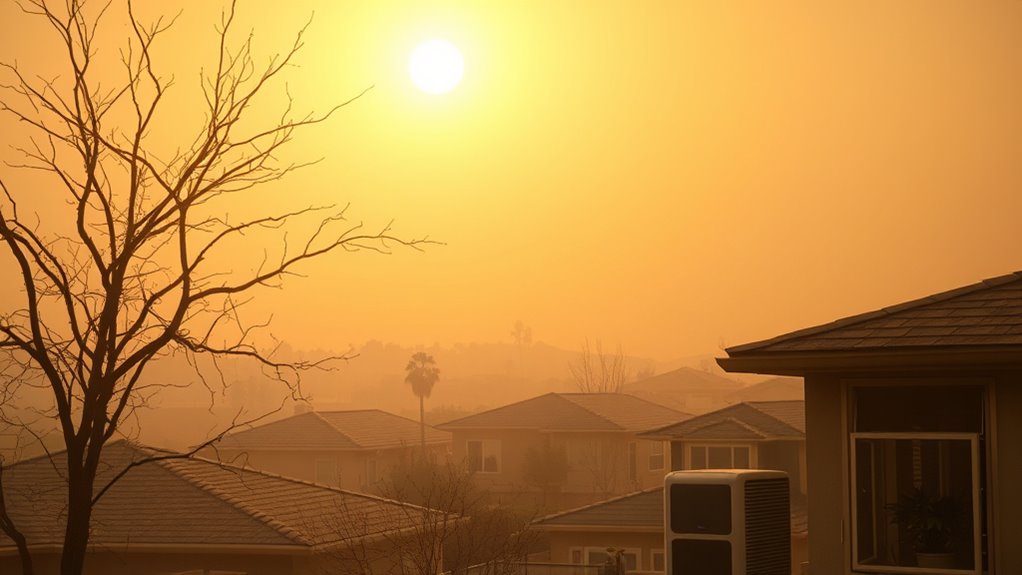
Wildfire smoke can quickly infiltrate your home and worsen allergy or respiratory issues if you’re unprepared. To protect yourself, focus on indoor air filtration systems that remove harmful particles and improve air quality. Use high-efficiency filters, like HEPA filters, and replace them regularly. Keep windows and doors closed during smoky days, and consider sealing gaps to prevent outdoor air from seeping in. Emergency preparedness also means having a plan in place, including supplies like masks, air purifiers, and extra filters. Stay informed about local air quality alerts and adjust your plans accordingly. Additionally, leveraging advanced data processing speeds can help you monitor real-time air quality updates more effectively. By taking these steps, you minimize smoke exposure and ensure your home remains a safe haven during wildfire events.
Tips for Protecting Respiratory Health in Dry Winter Conditions
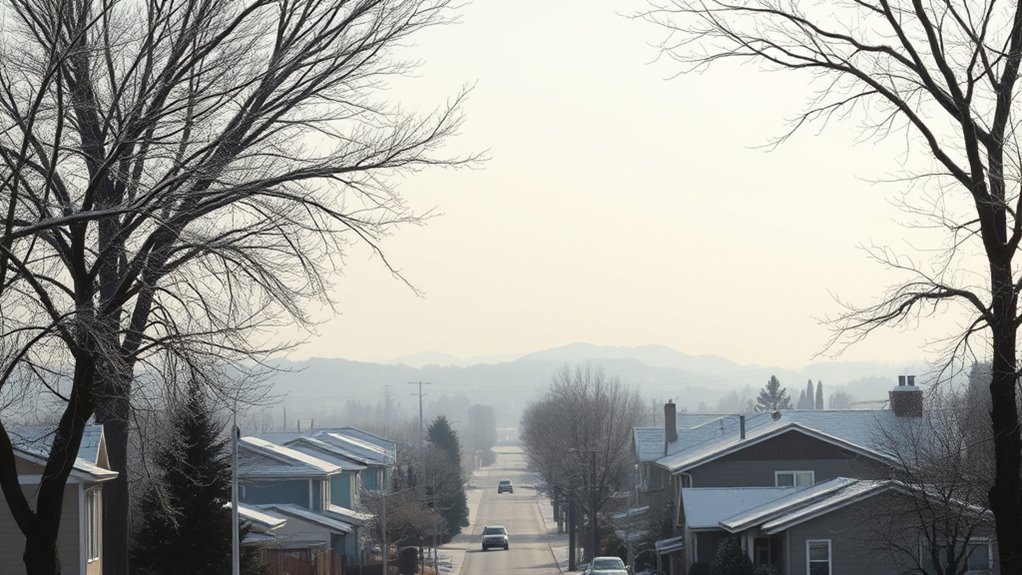
Dry winter conditions can markedly dry out your respiratory system, making it more vulnerable to irritation and infections. To combat this, maintain proper indoor humidity levels to keep air moist and your airways hydrated. Using a humidifier can help, especially in rooms where you spend a lot of time. Incorporate respiratory exercises into your daily routine to strengthen your lungs and improve airflow. Avoid prolonged exposure to dry air by limiting time outdoors during harsh weather. Also, stay well-hydrated by drinking plenty of fluids. Regularly clean your indoor environment to reduce dust and allergens. These simple steps will help protect your respiratory health and keep your airways functioning smoothly throughout winter. Additionally, understanding the impact of air quality on your respiratory system can help you better adjust your environment and routines for optimal health.
Monitoring Air Quality and Staying Informed Throughout the Year
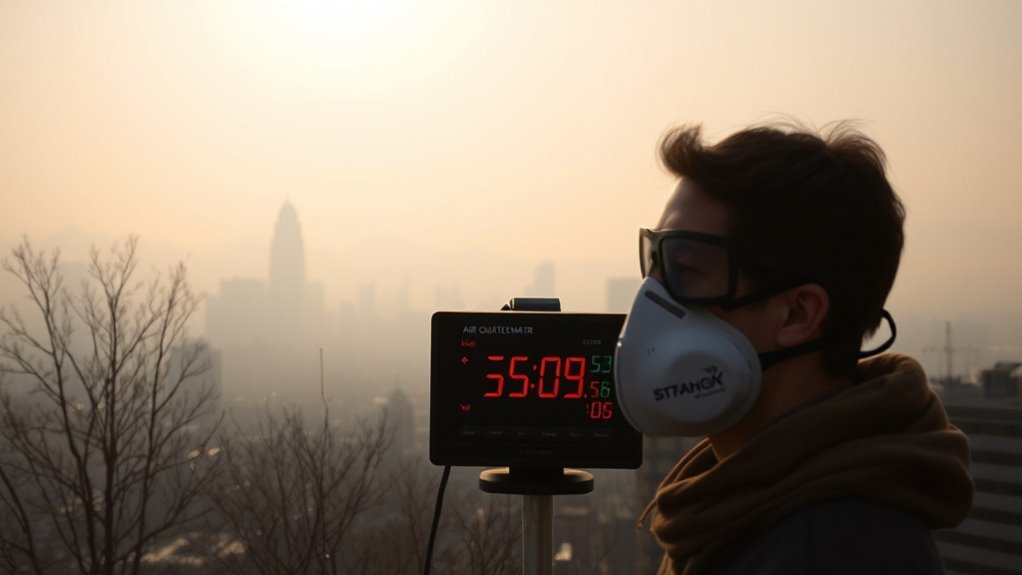
Maintaining good respiratory health relies not only on indoor air quality but also on staying informed about outdoor air conditions throughout the year. Monitoring outdoor air quality helps you identify days when pollution levels, allergens, or wildfire smoke could harm your lungs. Wearable sensors make this easier by providing real-time data on air quality as you go about your day. These devices can alert you when pollution spikes or allergen levels increase, so you can take protective measures like limiting outdoor activity or using a mask. Keeping track of air quality trends allows you to plan ahead for high-risk days and adjust your routines accordingly. Understanding the importance of Vetted air quality information is essential for making informed decisions. Staying informed ensures you can better protect your respiratory health, no matter the season or outdoor conditions.
Frequently Asked Questions
How Can Indoor Plants Improve Air Quality During Allergy Season?
Indoor plants can improve air quality during allergy season by actively filtering pollutants and allergens. Choose plants with air filtration qualities, like spider plants or peace lilies, that help remove airborne irritants. Proper plant selection enhances your indoor environment, reducing allergy symptoms. Regularly caring for and cleaning your plants also minimizes mold and dust buildup, creating a healthier, more comfortable space during challenging seasons.
Are There Specific Masks Better Suited for Wildfire Smoke Protection?
Think of choosing a mask like selecting armor for a battle. For wildfire protection, N95 masks are your best bet because of their high mask effectiveness at filtering out smoke particles. I once saw a neighbor breathe easier after donning an N95 during a wildfire, proving its value. These masks provide superior wildfire protection, making them essential when air quality deteriorates. Don’t settle for less—your lungs deserve the best shield.
What Dietary Changes Can Help Reduce Allergy Symptoms?
To reduce allergy symptoms, you should focus on nutritional strategies that support your immune system. Incorporate anti-inflammatory foods like fruits, vegetables, and omega-3-rich fish, which can help ease inflammation caused by allergies. Be mindful of food sensitivities that may worsen symptoms, and consider avoiding common triggers like dairy or processed foods. Staying hydrated and adding local honey might also help your body adapt to seasonal allergens.
How Does Humidity Level Affect Indoor Air Quality in Winter?
You should pay attention to humidity levels because they directly impact indoor air quality. Proper humidity control helps keep moisture levels balanced, preventing mold growth and dust mites that thrive in high humidity. During winter, using humidifiers or dehumidifiers can maintain ideal moisture levels, making the air more comfortable and reducing respiratory issues. Maintaining the right humidity not only improves air quality but also supports overall health during colder months.
Can Air Purifiers Eliminate All Airborne Allergens and Pollutants?
Imagine telling your future self about air purifiers—trust me, they’re handy but not magic. They can markedly reduce airborne allergens and pollutants, boosting your indoor air quality. However, air purifier limitations mean they don’t eliminate everything. Their allergen removal efficacy varies based on filter type and size, so while they improve air quality, you shouldn’t rely solely on them for total purification. Regular cleaning and proper ventilation remain essential.
Conclusion
Think of your lungs as a garden that needs tending through each season’s challenges. As spring blooms bring pollen, summer’s smoke drifts in, and winter’s dryness dries out your air, you’re the gardener protecting your space. By staying aware of air quality and taking simple steps, you’re watering and nourishing this garden. With consistent care, you’ll help your respiratory health flourish, no matter what season blows your way.
